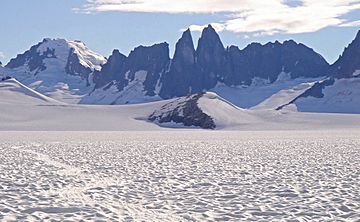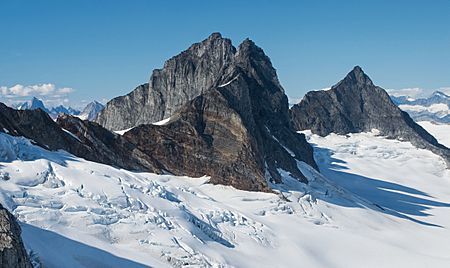Taku Towers facts for kids
Quick facts for kids Taku Towers |
|
|---|---|

Taku Towers, centered, east aspect
(Emperor Peak to left) |
|
| Highest point | |
| Elevation | 6,653+ ft (2,030+ m) |
| Prominence | 1,103 ft (336 m) |
| Isolation | 1.2 mi (1.9 km) |
| Parent peak | Emperor Peak |
| Geography | |
| Location | Tongass National Forest Juneau Borough Alaska, United States |
| Parent range | Coast Mountains Boundary Ranges Juneau Icefield |
| Topo map | USGS Juneau C-2 |
Taku Towers is a tall mountain in Alaska, United States. It stands at over 6,653 feet (2,028 meters) high. This mountain is special because it has two main peaks, like a double top. These peaks are about 0.2 miles apart.
Taku Towers is part of the Boundary Ranges in the Coast Mountains. It is located within the Juneau Icefield. The mountain is about 21 miles north of Juneau, Alaska. It sits on land that is part of the Tongass National Forest.
The name "Taku" was used by local people before it was officially published in 1960. Many places nearby also have the "Taku" name. This name comes from the Taku people, who are a group of Native Americans. The first people to climb Taku Towers reached the top in 1949. They climbed the west ridge. Later, in 1973, another group made the first climb up the difficult east face of the South Taku Tower.
Contents
Climate and Weather at Taku Towers
What Kind of Climate Does Taku Towers Have?
Taku Towers is in a "subpolar oceanic climate" zone. This means it has long, cold, and snowy winters. The summers are usually cool.
How Weather Forms in the Mountains
Weather systems often come from the Gulf of Alaska. When these systems reach the Coast Mountains, the air is forced to rise. This process is called "orographic lift." As the air goes higher, it cools down. This cooling causes a lot of rain and snow to fall on the mountains.
Temperatures and Best Time to Visit
Temperatures at Taku Towers can get very low. They can drop below -20 °C (-4 °F). With wind, it can feel even colder, sometimes below -30 °C (-22 °F). If you want to see or climb Taku Towers, the month of July usually has the best weather.



